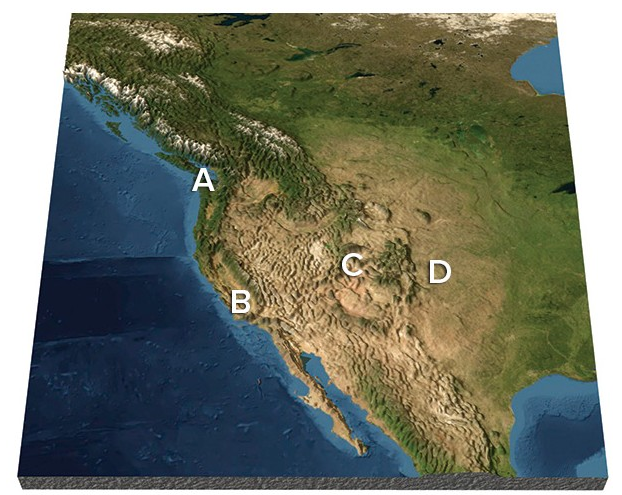Which of the following locations has the greatest chance of experiencing Chinook winds?

A) A
B) B
C) C
D) D
D) D
You might also like to view...
From which two regions does Japan purchase much of its seafood for domestic consumption?
A) Africa and the Middle East B) Japan largely relies on seafood caught domestically within Japanese waters C) Europe and Russia D) Europe and North America E) Latin America and Southeast Asia
Determine the gradients of three segments of the Eds Creek drainage basin: a first-order stream between Points 1 and 2; a second-order stream between Points 2 and 3; and a thirdorder stream (Eds Creek) between Points 3 and 4. Use the ruler function to determine distances (to the nearest 0.01 miles) and the elevation change between points.
To answer the following questions, go to the Hess Physical Geography Laboratory Manual, 12th edition, website at www.MasteringGeography.com, then Exercise 39 and select “Exercise 39 Part IV Google Earth™” to open a KMZ file in Google Earth, or scan the QR (Quick Response) code for this exercise and view “Exercise 39 Part IV Google EarthTM video.” In this exercise you’ll compare the characteristics of streams in the Eds Creek drainage basin in Montana (also shown in Map T-3 and Figure 39-3).
(a) Fly to Point 2, then determine the gradient of the first-order stream (between Point 1 and Point 2).
(b) Fly to Point 3, then determine the gradient of the second-order stream (between Point 2 and Point 3).
(c) Fly to Point 4, then determine the gradient of the third-order stream (between Point 3 and Point 4).
A scientific theory must be:
a) Based on confirmed observations b) Able to explain ALL observations c) Consistent with every observation made and with every other scientific principle d) Internally consistent e) All of the above
Floodplains and wetlands are often managed properly.
Answer the following statement true (T) or false (F)